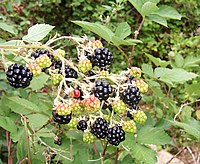
Photo from wikipedia
This study evaluated thirteen different black mulberry fruits (Morus nigra L.) grown in the Guangdong region in order to select the best cultivar for health benefits and commercial applications. The… Click to show full abstract
This study evaluated thirteen different black mulberry fruits (Morus nigra L.) grown in the Guangdong region in order to select the best cultivar for health benefits and commercial applications. The phenolic compounds were identified and quantified using UPLC-ESI-MS/MS. The antioxidant activity was evaluated by three in vitro methods. Significant differences among samples were found regarding total soluble solids (6.20–15.83 °Brix), titratable acidity (5.82–48.49 mg CA/g), total phenolic contents (10.82–27.29 mg GAE/g), total flavonoid contents (1.21–2.86 mg RE/g) and total anthocyanin contents (2.91–11.86 mg CE/g). Fifty-five different phenolic compounds were identified, of which fifteen were reported in mulberry for the first time, but only forty-six of them were quantitated. The DPPH radical scavenging activity, ABTS radical scavenging activity and ferric ion-reducing antioxidant power varied significantly among the samples. Overall, cultivars with better combinations of phenolic compounds and antioxidant activity were Qiong46 (M-2), Yuebanguo (M-4) and Heizhenzhu (M-10), which were recommended for commercial cultivation.
Journal Title: Foods
Year Published: 2022
Link to full text (if available)
Share on Social Media: Sign Up to like & get
recommendations!